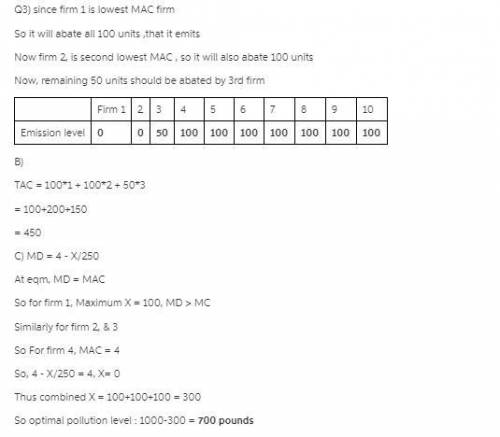
Business, 10.03.2020 08:51 rileyeddins1010
There are ten polluting firms, Firm1,. . . ,Firm10. Each firm emits 100 pounds of pollution prior to any regulations (so there are currently 1,000 pounds being emitted). Each firm has constant marginal abatement costs, but the costs vary across firms. Conveniently, the firms’ names indicate their marginal abatement costs. Firm1’s marginal abatement costs are constant at $1 per pound, Firm2’s marginal abatement costs are constant at $2 per pound,. . . , and Firm10’s marginal abatement costs are $10 per pound.
a. Suppose the regulator wants to achieve a 25% reduction in pollution (250 pounds). What is the cost effective allocation of emis- sions across the ten firms?
b. What are the total abatement costs for society to achieve a 250 pound reduction in emissions?
c. The marginal damage of pollution in this city is given by MD= 4-1/250 X, where X is the total reduction in pollution. What is the optimal level of pollution?

Answers: 3
Another question on Business

Business, 22.06.2019 00:30
What are six resources for you decide which type of business to start and how to start it?
Answers: 3


Business, 22.06.2019 03:40
Electronics assembly inc. is a contract manufacturer that assembles consumer electronics for a number of companies. currently, the operations manager is assessing the capacity requirements as input into a bid for a job to assemble cell phones for a major global company. the company would assemble three models of cell phones in the same assembly cell. setup time between the phones is negligible. electronics assembly inc. operates two 8-hour shifts for 275 days per year. cell phone demand forecast (phones/year) processing time (minutes/phone) mars 47,000 19.8 saturn 35,000 20.7 neptune 7,500 16.2 a. calculate total capacity required by line. b. determine the total operating time available. c. calculate the total number of assembly cells. (round up your answer to the next whole number.)
Answers: 2

Business, 22.06.2019 11:40
Zachary company produces commercial gardening equipment. since production is highly automated, the company allocates its overhead costs to product lines using activity-based costing. the costs and cost drivers associated with the four overhead activity cost pools follow: activities unit level batch level product level facility level cost $ 64,800 $ 27,730 $ 15,000 $ 154,000 cost driver 2,400 labor hrs. 47 setups percentage of use 11,000 units production of 780 sets of cutting shears, one of the company’s 20 products, took 240 labor hours and 7 setups and consumed 15 percent of the product-sustaining activities. required: (a) had the company used labor hours as a company wide allocation base, how much overhead would it have allocated to the cutting shears? (b) how much overhead is allocated to the cutting shears using activity-based costing? (c) compute the overhead cost per unit for cutting shears first using activity-based costing and then using direct labor hours for allocation if 780 units are produced. if direct product costs are $150 and the product is priced at 30 percent above cost for what price would the product sell under each allocation system? (d) assuming that activity-based costing provides a more accurate estimate of cost, indicate whether the cutting shears would be over- or underpriced if direct labor hours are used as an allocation base. explain how over-or undercosting can affect vaulker's profitability. (e) comment on the validity of using the allocated facility-level cost in the pricing decision. should other costs be considered in a cost- plus pricing decision? if so, which ones? what costs would you include if you were trying to decide whether to accept a special order?
Answers: 1
You know the right answer?
There are ten polluting firms, Firm1,. . . ,Firm10. Each firm emits 100 pounds of pollution prior to...
Questions








History, 14.07.2019 09:10


Mathematics, 14.07.2019 09:10


English, 14.07.2019 09:10


Mathematics, 14.07.2019 09:10


Mathematics, 14.07.2019 09:10



Mathematics, 14.07.2019 09:20

Social Studies, 14.07.2019 09:20




